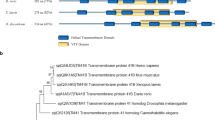Abstract
Three dominant mutations of mec-4, a gene needed for mechanosensation, cause the touch-receptor neurons of Caenorhabditis elegans to degenerate. With deg-1, another C. elegans gene that can mutate to induce neuronal degeneration and that is similar in sequence, mec-4 defines a new gene family. Cross-hybridizing sequences are detectable in other species, raising the possibility that degenerative conditions in other organisms may be caused by mutations in similar genes. All three dominant mec-4 mutations affect the same amino acid. Effects of amino-acid substitutions at this position suggest that steric hindrance may induce the degenerative state.
Similar content being viewed by others
References
Chalfie, M. & Sulston, J. Devl. Biol. 82, 358–370 (1981).
Chalfie, M. & Wolinsky, E. Nature 345, 410–416 (1990).
Coombe, P. E. & Heisenberg, M. J. Neurogenet. 3, 135–158 (1986).
Adams, R. D. & Victor, M. 3rd Edn, in Principles of Neurology 859–901 (McGraw Hill, New York, 1985).
Chalfie, M. & Au, M. Science 243, 1027–1033 (1989).
Way, J. C. & Chalfie, M. Genes Dev. 3, 1823–1833 (1989).
Herman, R. K. Genetics 116, 377–388 (1987).
Ellis, H. M. & Horvitz, H. R. Cell 44, 817–829 (1986).
Coulson, A., Sulston, J., Brenner, S. & Karn, J. Proc. natn. Acad. Sci. U.S.A. 83, 7821–7825 (1986).
Kyte, J. & Doolittle, R. F. J. molec. Biol. 157, 105–132 (1982).
Carpenter, G. A. Rev. Biochem. 56, 881–914 (1987).
Yamamoto, T., Bishop, R. W., Brown, M. S., Goldstein, J. L. & Russell, D. W. Science 232, 1230–1237 (1986).
Herz, J. et al. EMBO J. 7, 4119–4127 (1988).
Shirai, T. et al J. Biochem. 103, 281–285 (1988).
Kayano, T., Noda, M., Flockerzi, V., Takahashi, H. & Numa, S. FEBS Lett. 228, 187–194 (1888).
Noda, M. et al Nature 312, 121–127 (1984).
Noda, M. et al Nature 320, 188–192 (1986).
Coulondre, C. & Miller, J. H. J. molec. Biol. 117, 577–606 (1977).
Garnier, J., Osguthorpe, D. J. & Robson, B. J. molec. Biol. 120, 97–120 (1978).
Doh-ura, K., Tateishi, J., Saski, H., Kitamoto, T. Sakai, Y. Biochem. biophys. Res. Commun. 163, 974–979 (1989).
Gustin, M. C., Zhou, X.-L., Martinac, B. & Kung, C. Science 242, 762–765 (1988).
Hirano, A. & Dembitzer, H. M. J. Neuropath. exp. Neurol. 34, 1–11 (1974).
Caddy, K. W. T. & Briscoe, T. J. Brain Res. 91, 276–280 (1975).
Landis, S. C. & Mullen, R. J. J. comp. Neurol. 177, 125–144 (1978).
Duchen, L. W. & Strich, S. J. (appendix, Falconer, D.S.) J. Neurol. Neurosurg. Psychiat. 31, 535–542 (1968).
Green, M. C., Sidman, R. L. & Pivetta, O. H. Science 176, 800–805 (1972).
Messer, A., Strominger, N. L. & Mazurkiewicz, J. E. J. Neurogenet. 4, 201–213 (1987).
Hayden, M. R. Huntington's Chorea (Springer-Verlag, Berlin, 1981).
Mulder, D. W., Kurland, L. T., Offord, K. P. & Beard, M. Neurol. 36, 511–517 (1986).
Fire, A. EMBO J. 5, 2673–2680 (1986).
Kramer, J., French, R. P., Park, E. & Johnson, J. J. Molec. cell. Biol. 10, 2081–2089 (1990).
Stinchcomb, D. T., Shaw, J. E., Carr, S. H. & Hirsh, D. Molec. cell. Biol. 5, 3484–3496 (1985).
Sanger, F., Nicklen, S. & Coulson, A. R. Proc. natn. Acad. Sci. U.S.A. 74, 5463–5467 (1977).
Kunkel, T. A., Roberts, J. D. & Zakar, R. A. Meth. Enzym. 154, 367–382 (1987).
Emmons, S. & Esner, L. Cell 36, 599–605 (1984).
Sambrook, J., Fritsch, E. F. & Maniatis, T. Molecular Cloning: A Laboratory Manual 2nd Edn (Cold Spring Harbor Laboratory, New York, 1989).
Brenner, S. Genetics 77, 71–94 (1974).
Collins, J., Saari, B. & Anderson, P. Nature 328, 726–728 (1987).
Emmons, S. C., Klass, M. R., & Hirsch, D. Proc. natn. Acad. Sci. U.S.A. 76, 1333–1337 (1979).
Palazzolo, M. J. et al. Gene 88, 25–36 (1990).
Henikoff, S. Gene 28, 351–359 (1984).
Queen, C. & Korn, L. J. Nucleic Acids Res. 12, 581–599 (1984).
Pearson, W. R. & Lipman, D. J. Proc. natn. Acad. Sci. U.S.A. 85, 2444–2448 (1988).
Southern, E. M. J. molec. Biol. 98, 503–517 (1975).
Author information
Authors and Affiliations
Rights and permissions
About this article
Cite this article
Driscoll, M., Chalfie, M. The mec-4 gene is a member of a family of Caenorhabditis elegans genes that can mutate to induce neuronal degeneration. Nature 349, 588–593 (1991). https://doi.org/10.1038/349588a0
Received:
Accepted:
Issue Date:
DOI: https://doi.org/10.1038/349588a0
- Springer Nature Limited
This article is cited by
-
A guide to cell death pathways
Nature Reviews Molecular Cell Biology (2023)
-
Muscle and epidermal contributions of the structural protein β-spectrin promote hypergravity-induced motor neuron axon defects in C. elegans
Scientific Reports (2020)
-
Comparative electrophysiological analysis of the bile acid-sensitive ion channel (BASIC) from different species suggests similar physiological functions
Pflügers Archiv - European Journal of Physiology (2019)
-
Acid-sensing ion channels: dual function proteins for chemo-sensing and mechano-sensing
Journal of Biomedical Science (2018)
-
Modulation of the FMRFamide-gated Na+ channel by external Ca2+
Pflügers Archiv - European Journal of Physiology (2017)





